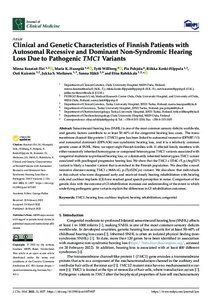Clinical and Genetic Characteristics of Finnish Patients with Autosomal Recessive and Dominant Non-Syndromic Hearing Loss Due to Pathogenic TMC1 Variants
Kraatari-Tiri Minna; Haanpää Maria K.; Willberg Tytti; Pohjola Pia; Keski-Filppula Riikka; Kuismin Outi; Moilanen Jukka S.; Häkli Sanna; Rahikkala Elisa
Clinical and Genetic Characteristics of Finnish Patients with Autosomal Recessive and Dominant Non-Syndromic Hearing Loss Due to Pathogenic TMC1 Variants
Kraatari-Tiri Minna
Haanpää Maria K.
Willberg Tytti
Pohjola Pia
Keski-Filppula Riikka
Kuismin Outi
Moilanen Jukka S.
Häkli Sanna
Rahikkala Elisa
MDPI
Julkaisun pysyvä osoite on:
https://urn.fi/URN:NBN:fi-fe2022081153858
https://urn.fi/URN:NBN:fi-fe2022081153858
Tiivistelmä
Sensorineural hearing loss (SNHL) is one of the most common sensory deficits worldwide, and genetic factors contribute to at least 50-60% of the congenital hearing loss cases. The transmembrane channel-like protein 1 (TMC1) gene has been linked to autosomal recessive (DFNB7/11) and autosomal dominant (DFNA36) non-syndromic hearing loss, and it is a relatively common genetic cause of SNHL. Here, we report eight Finnish families with 11 affected family members with either recessively inherited homozygous or compound heterozygous TMC1 variants associated with congenital moderate-to-profound hearing loss, or a dominantly inherited heterozygous TMC1 variant associated with postlingual progressive hearing loss. We show that the TMC1 c.1534C>T, p.(Arg512*) variant is likely a founder variant that is enriched in the Finnish population. We describe a novel recessive disease-causing TMC1 c.968A>G, p.(Tyr323Cys) variant. We also show that individuals in this cohort who were diagnosed early and received timely hearing rehabilitation with hearing aids and cochlear implants (CI) have reached good speech perception in noise. Comparison of the genetic data with the outcome of CI rehabilitation increases our understanding of the extent to which underlying pathogenic gene variants explain the differences in CI rehabilitation outcomes.
Kokoelmat
- Rinnakkaistallenteet [27094]
